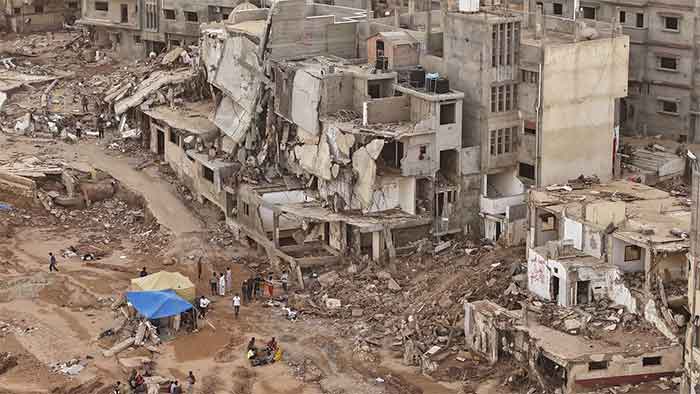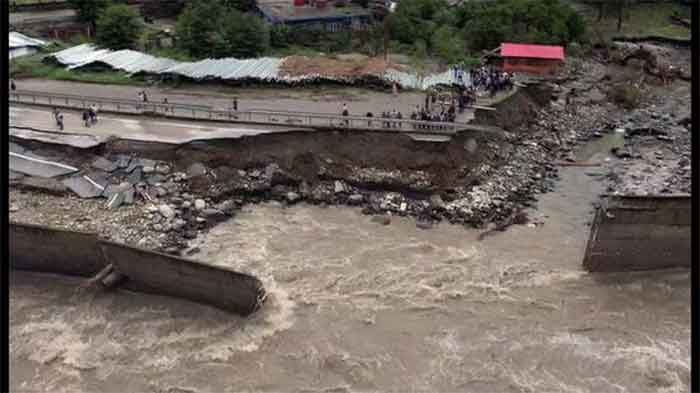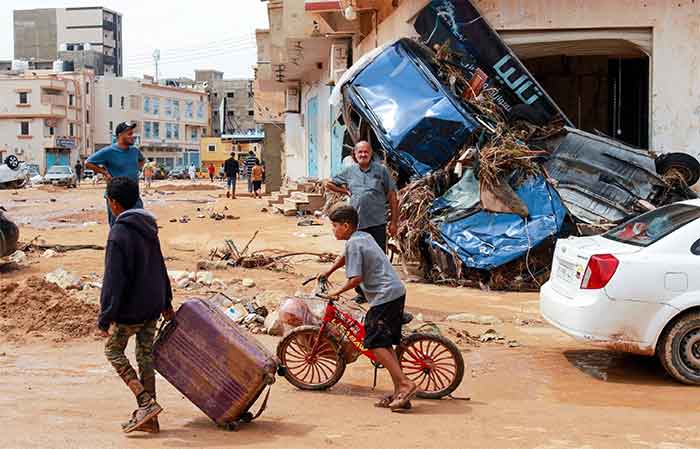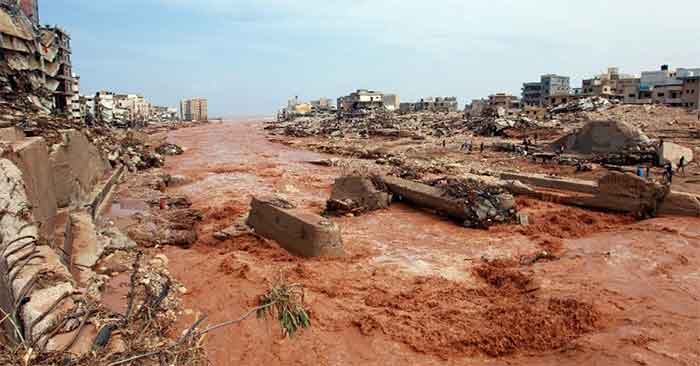
Following heavy rain in many parts of Himachal Pradesh and Uttarakhand in western Himalayan region in July 2023 there were reports of abnormally high incidence of landslides, floods and flash floods during this month. As there were simultaneous heavy rains in many plain areas below the hills, the local rainfall as well as the floodwater from the hills combined to create abnormally high floods in vast plain areas, in rural as well urban areas, in major food grain producing areas of Punjab and Haryana.
Several standing vegetable crops were adversely affected, as well as orchards of apples and other fruits. In the Himalayan region orchardists in badly affected places like Kullu-Manali belt also worried about the transport of their soon-to-be-harvested fruits to markets below due to badly damaged roads.
Hundreds of roads and highways widened at great cost recently were damaged at various stretches, sometimes in very serious ways, roads at some places looking as though some giant monster had clawed away huge portions in a big grab. Electricity supply was disrupted in many hilly areas for several days as repairs took their own time. In the middle of all the rain and water, drinking water supplies to many hilly areas were disrupted due to excessive silt in water or water channels or pipes getting damaged.
Even Delhi located at a longer distance from hills had abnormally wider and more prolonged floods. Parts of cities like Chandigarh and Mohali not generally used to flood situations saw heavy flooding for a short duration. Several famous pilgrimage routes and pilgrims were adversely affected and saw many anxious moments. Several hotels which had experiences a boom in the previous month saw a sudden slump and in fact several employees lost their jobs.
At the end of the month of July 2023 estimates of economic losses caused by floods and related disasters in Himachal Pradesh alone were stated to be at over Rs. 8000 crores ( one crore=10 million), which is several times the loss for this period in several previous years. Nearly 1000 roads were damaged or blocked, as were about 40 bridges. Punjab reported nearly 1500 villages flooded in 19 districts, while Haryana reported about 1400. In Delhi over 25,000 people had to be temporarily evacuated from flood-affected areas.
About 300 people lost their life in North India in July alone, over half of them in the worst affected state of Himachal Pradesh. However the situation could easily have been much worse but for the timely and brave efforts of rescue workers. In Himachal Pradesh alone over one hundred thousand tourists as well local people were rescued from some difficult and dangerous situations during this month. Several officials performed well too, and in this context some women officers in particular have drawn much praise and appreciation.
While excessive water released from dams caused some deaths and much devastation in Himachal (where some people complained bitterly that they had not received advance notice of this release and where advance warning systems remain very adequate despite pressing need for these), a much-feared bigger tragedy related to this could be averted as there was some respite from heavier rains at a critical time.
In these times of climate change there is a tendency to link most such tragedies to climate change and certainly there was abnormally heavy rain concentrated in a small span of time. Moreover, as in parts of Himachal Pradesh, there had been abnormally frequent rain even in the days preceding the advent of monsoon rains. At the same time, placing all blame on abnormally high and concentrated rain related to climate change will not be proper as several local factors have been increasing the vulnerability to floods and landslides, particularly in the hilly regions but to some extent also in the plains below. In the Himalayan region it is the entire development model which should be questioned as this has badly disrupted the fragile ecology and geology of the region making it very vulnerable to higher harm from landslides and floods. The result is that several disasters are reported even in deficit rainfall years. The problems relating to Beas Satluj Link project have troubled people much and should be an eye-opener in the context of other river-link projects.
The first month of the monsoon season July has seen so much harm and so one must be very careful regarding the remaining days. If we look at the experience of this year so far as well as the experience of the previous year, there are several examples of big harm in fragile areas which could have been avoided by better cautionary steps. The Chakki railway bridge on the Pathankot-Jogindernagar narrow gauge railway track collapsed last year. This was a known danger zone as repair of pillars had been taken up in recent times but the more extensive repair or reconstruction work needed was not taken up. The Pathankot-Mandi highway also suffered extensive damage. Indiscriminate construction and road cutting has led to the creation or aggravation of many permanent landslide zones here and the situation worsens at the time of heavy rains.
In the case of very costly damage caused to some bridges there have been reports that excessive sand mining may have been an important reason for the weakening of these bridges.
A recent report by the state government has stated that Himachal Pradesh is vulnerable to 25 out of 33 hazards identified by the Government of India. Overall, the districts of Chamba, Kinnaur and Kullu, as well as parts of Kangra and Shimla fall in the ‘very high’ vulnerable status. When looked at in the context of earthquakes, the districts of Kangra, Hamirpur and Mandi fall in the ‘very high’ vulnerability category.
In this context the extent to which risks can be aggravated by the location of several hydro-electricity projects in high-risk areas and high seismicity areas has been frequently debated. There are several aspects of this debate. One aspect relates to the extent to which these structures are safe in high seismicity areas (will be safe at the time of a high intensity earthquake). Another aspect relates to the extent to which threats and risks increase in the course of the construction process which frequently involves not just the use of heavy machinery but also often blasting work and serious problems relating to disposal of mounds of rubble. Another aspect of risks relates to reservoir induced seismicity. Yet another aspect relates to the discharge of floodwaters to avoid water-topping at the time of very heavy rains, or dams not being ready to receive any further rain flows.
Have all these risks been taken care of while approving these projects? Given the sensitive ecology and fragile as well as complex (from the point of view of dam-construction) geological conditions of the region, is it really advisable to go ahead with several of the controversial hydro-electricity projects of the region?
Are these projects even desirable and viable in economic terms, given the long delays and cost overruns? A parliamentary committee on energy reported recently that the 800 MW Parbati-II project earlier billed at Rs. 3900 crore ( one crore=10 million) has a cost over-run of Rs. 5400 crore so that it is now estimated to cost Rs. 9300 crore. Where is the guarantee that a project found viable at the cost of Rs. 3900 crore is still viable following a 139% rise to Rs. 9300 crore?
Such questions can be raised also about the 100 MW Uhl-III which has experienced 197% cost rise, or the Sawra Kaddu project which has experienced cost rise of 111%.
Another question relates to the carrying capacity of geologically and ecologically fragile systems regarding how many of such projects they can really absorb or tolerate, and whether the exploitation plans are much in excess of this carrying capacity.
In the case of several highway construction and highway widening projects there have been many cases of indiscriminate cutting of slopes, excessive tree felling, unsafe practices of rubble disposal and other factors leading to the emergence of many more landslide zones as well as aggravation of the threat from floods.
Indiscriminate mining, particularly in and round rivers and water-sources for sand, has also led to increasing the threat from floods during rains (while at the same contributing to rapid depletion of water during the dry season).
Improper disposal of muck and debris resulting from construction projects or mining has become a major cause of aggravating the danger from floods and making them highly destructive. Those terribly menacing floods which emerge roaring from hills carrying huge boulders and stones are of course much more destructive than the ordinary spilling over of rivers.
In the context of the floods of plain areas, particularly in Delhi, many serious questions have been raised regarding the flouting of flood-zoning norms, the filling up of wetlands and the neglect of drainage systems which have contributed to aggravating the threat of floods.
These times of climate change are identified with several kinds of adverse weather situations, including concentration of heavy rainfall in a short time span. In such a situation there is need for more ecologically protective policies but the actual situation appears to be moving in the opposite direction. Therefore there is clear need for corrective actions in favor of an ecologically protective path which will also protect people from disasters. This in turn calls for more far-reaching changes in development priorities particularly in the Himalayan region compared to what the governments have been willing to consider. We should not wait for worse disasters to happen before taking urgent, wider remedial actions.
Bharat Dogra is Honorary Convener, Campaign to Save Earth Now. His recent books include Planet in Peril, Protecting Earth for Children and A Day in 2071.















































